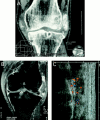Imaging of tophaceous gout: computed tomography provides specific images compared with magnetic resonance imaging and ultrasonography
- PMID: 11779759
- PMCID: PMC1753862
- DOI: 10.1136/ard.61.1.52
Imaging of tophaceous gout: computed tomography provides specific images compared with magnetic resonance imaging and ultrasonography
Abstract
Objective: To determine the usefulness of computed tomography (CT), magnetic resonance imaging (MRI), and Doppler ultrasonography (US) in providing specific images of gouty tophi.
Methods: Four male patients with chronic gout with tophi affecting the knee joints (three cases) or the olecranon processes of the elbows (one case) were assessed. Crystallographic analyses of the synovial fluid or tissue aspirates of the areas of interest were made with polarising light microscopy, alizarin red staining, and x ray diffraction. CT was performed with a GE scanner, MR imaging was obtained with a 1.5 T Magneton (Siemens), and ultrasonography with colour Doppler was carried out by standard technique.
Results: Crystallographic analyses showed monosodium urate (MSU) crystals in the specimens of the four patients; hydroxyapatite and calcium pyrophosphate dihydrate (CPPD) crystals were not found. A diffuse soft tissue thickening was seen on plain radiographs but no calcifications or ossifications of the tophi. CT disclosed lesions containing round and oval opacities, with a mean density of about 160 Hounsfield units (HU). With MRI, lesions were of low to intermediate signal intensity on T(1) and T(2) weighting. After contrast injection in two cases, enhancement of the tophus was seen in one. Colour Doppler US showed the tophi to be hypoechogenic with peripheral increase of the blood flow in three cases.
Conclusion: The MR and colour Doppler US images showed the tophi as masses surrounded by a hypervascular area, which cannot be considered as specific for gout. But on CT images, masses of about 160 HU density were clearly seen, which correspond to MSU crystal deposits.
Figures


Publication types
MeSH terms
Substances
LinkOut - more resources
Full Text Sources
Medical

